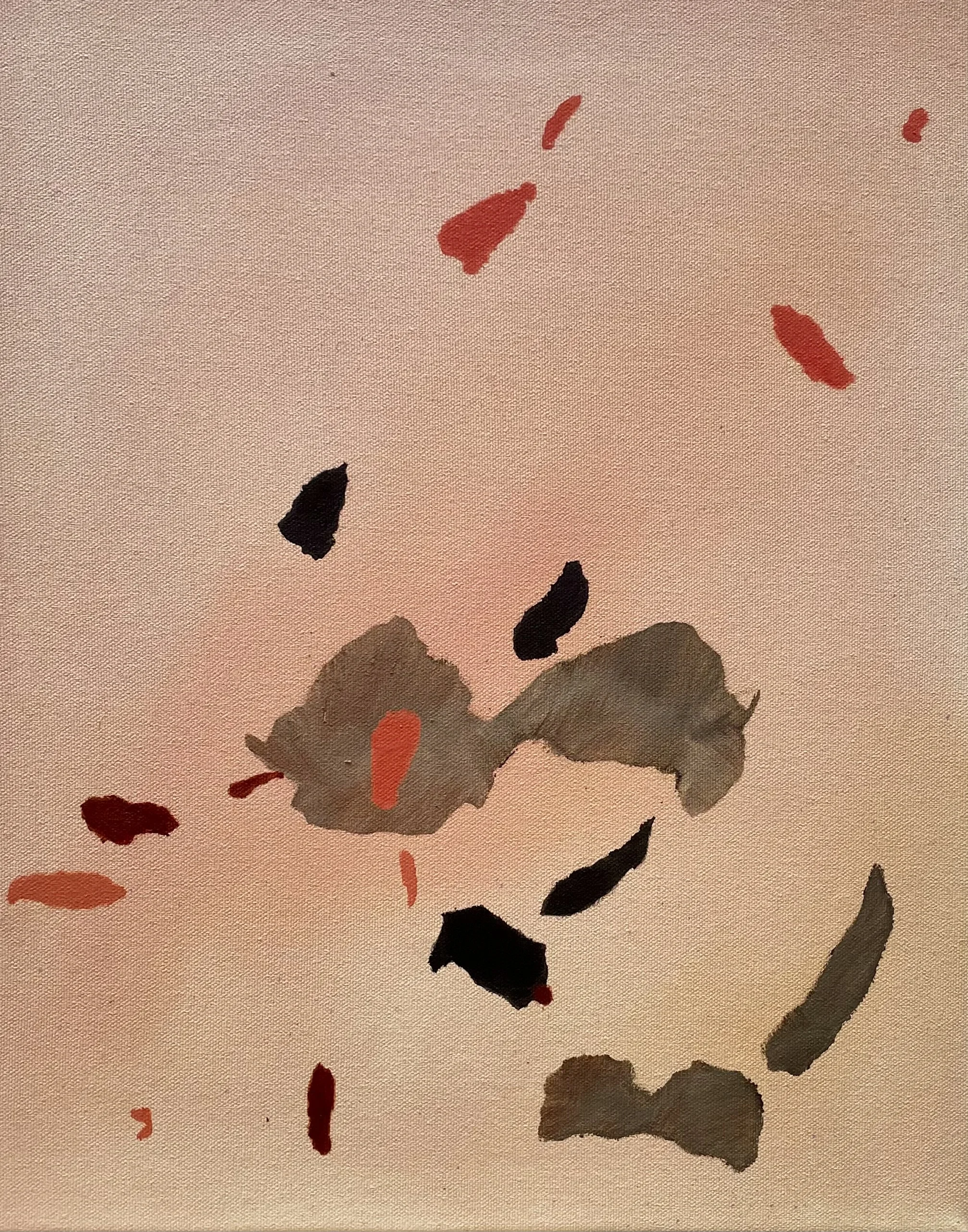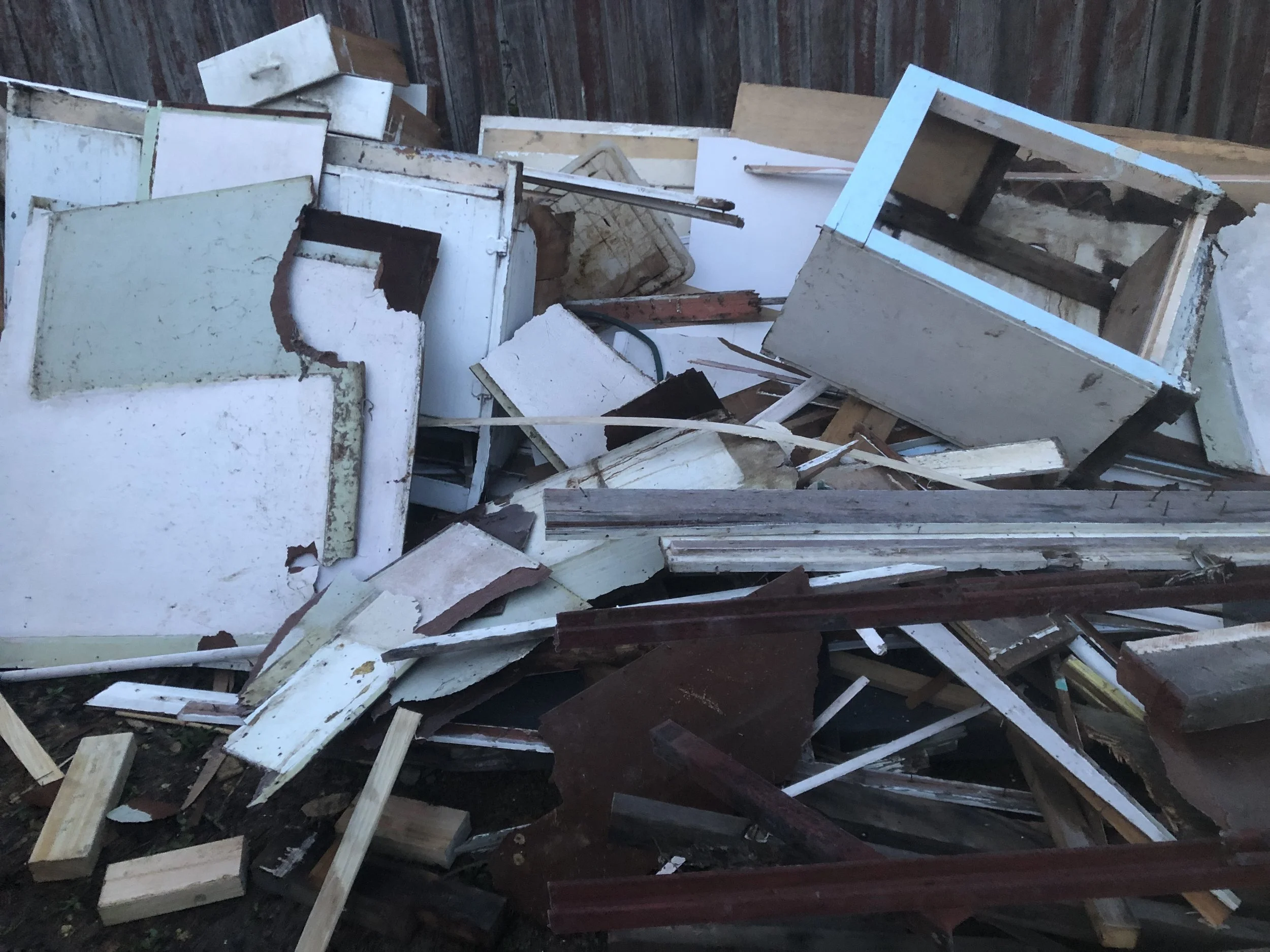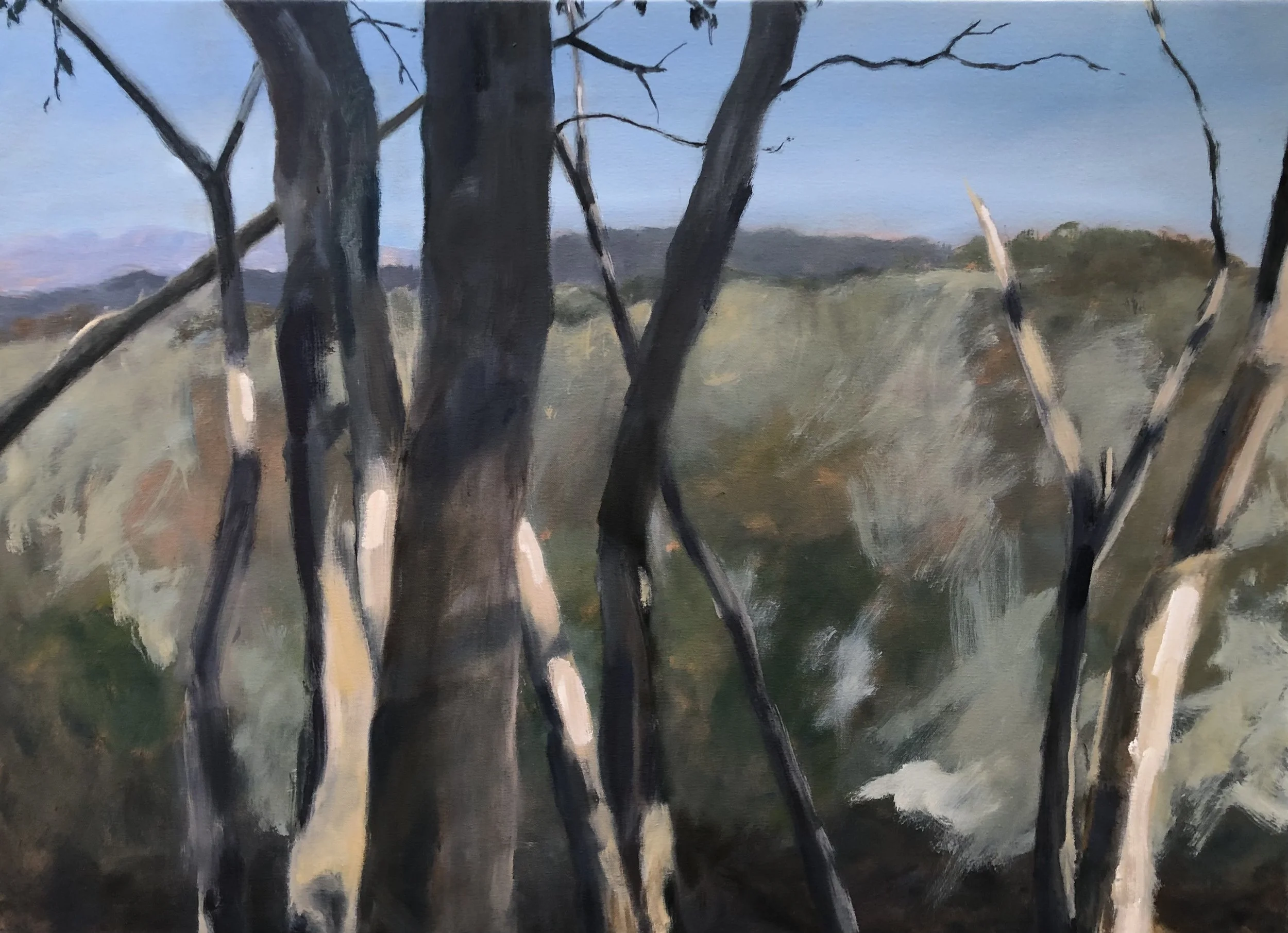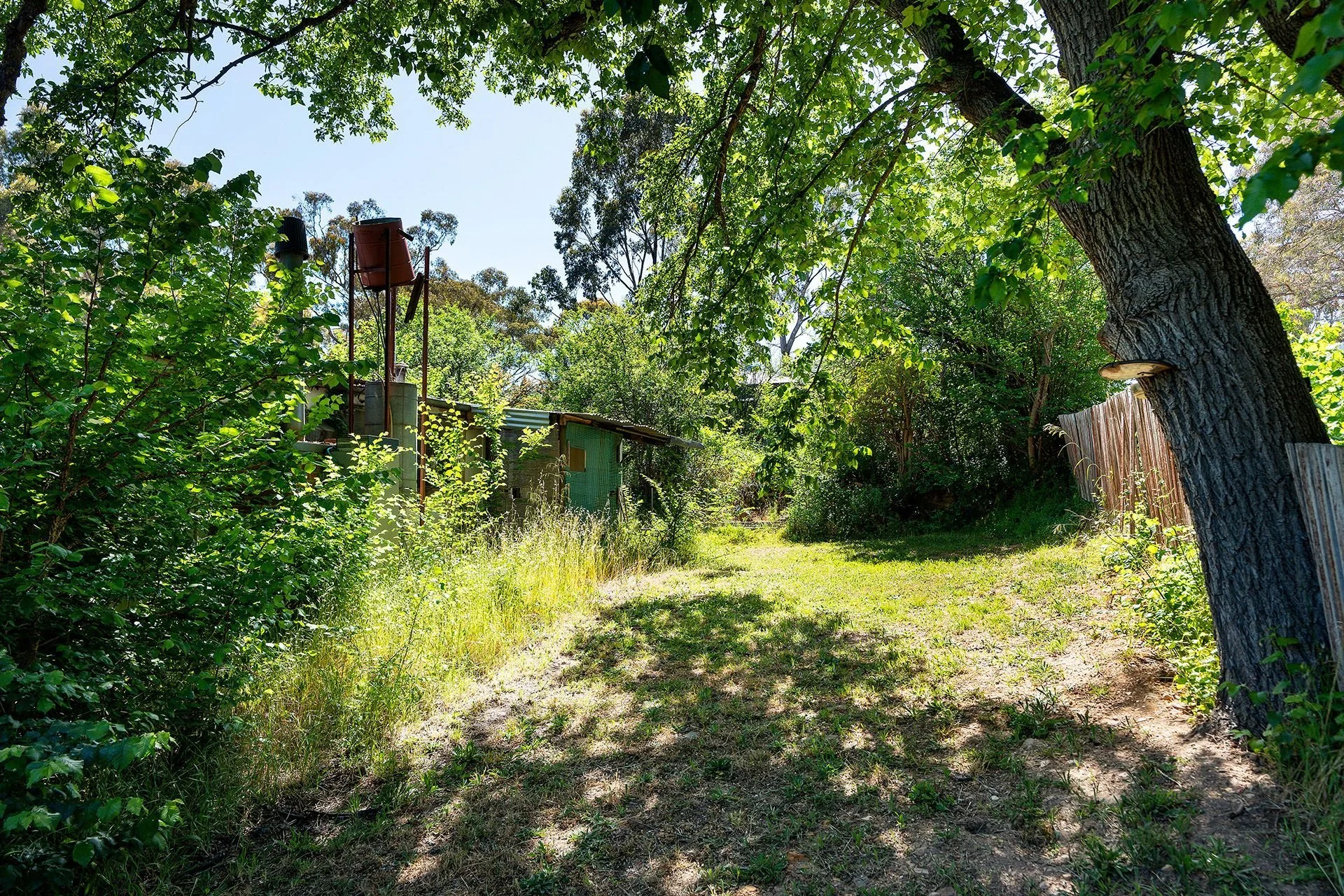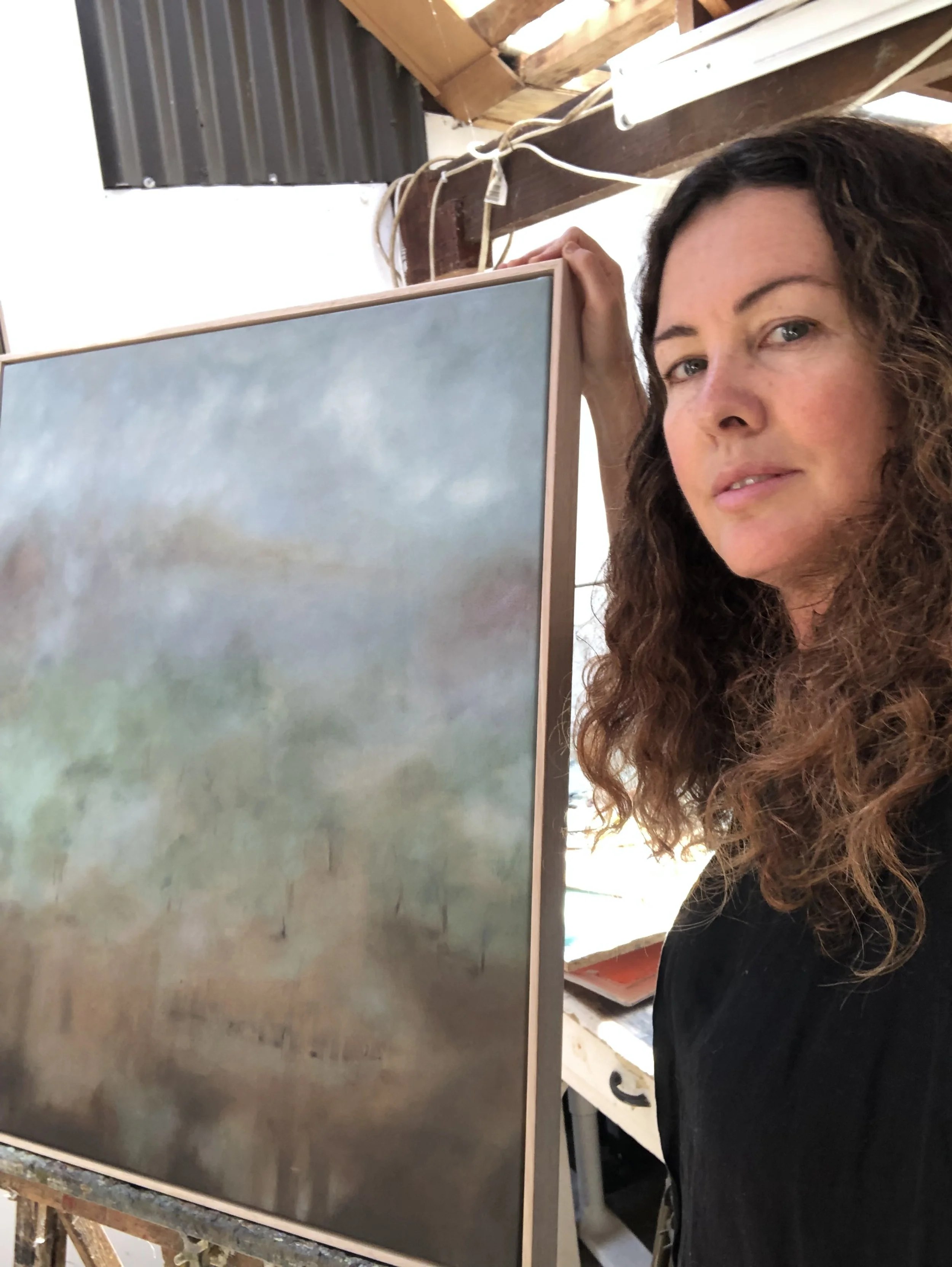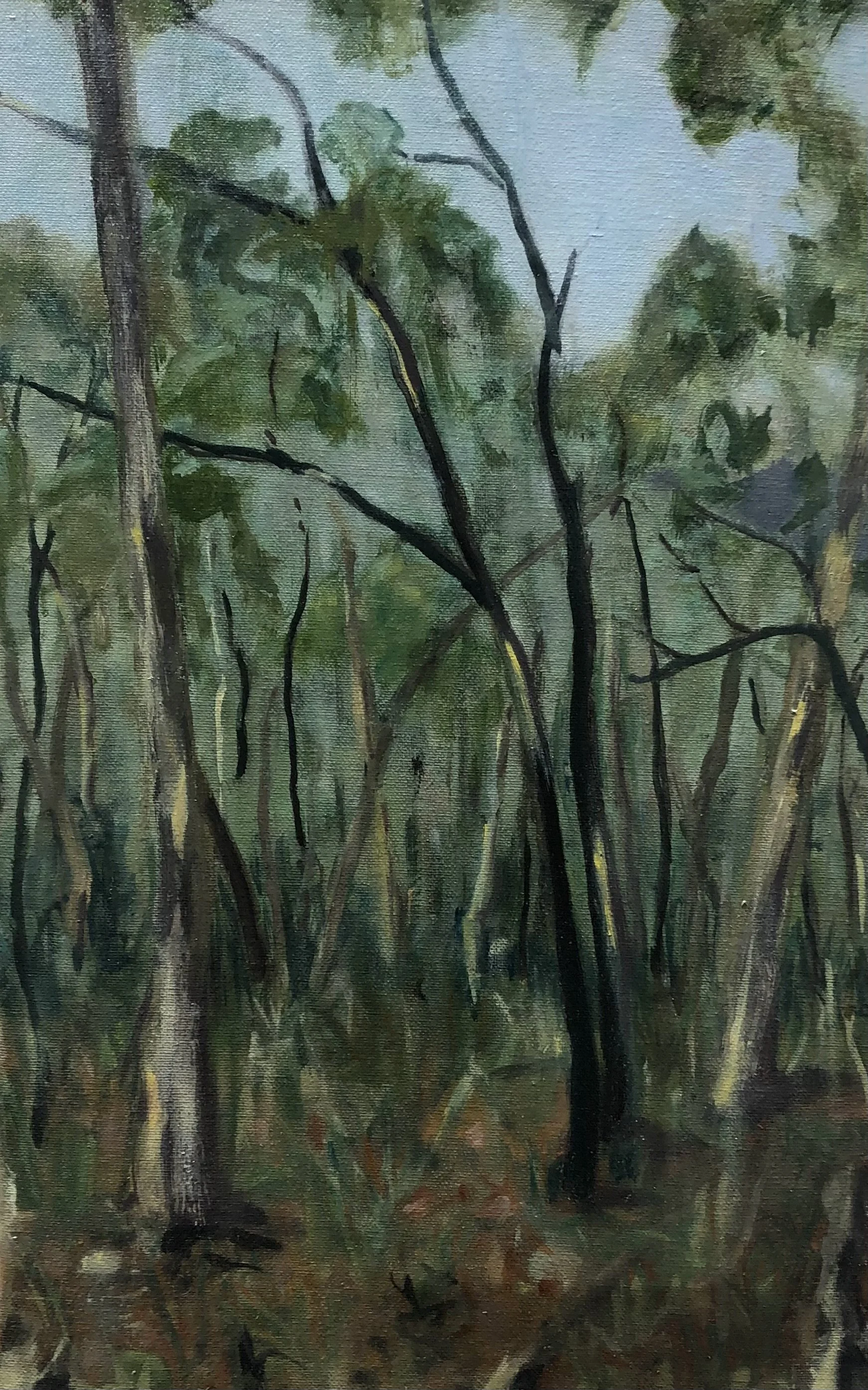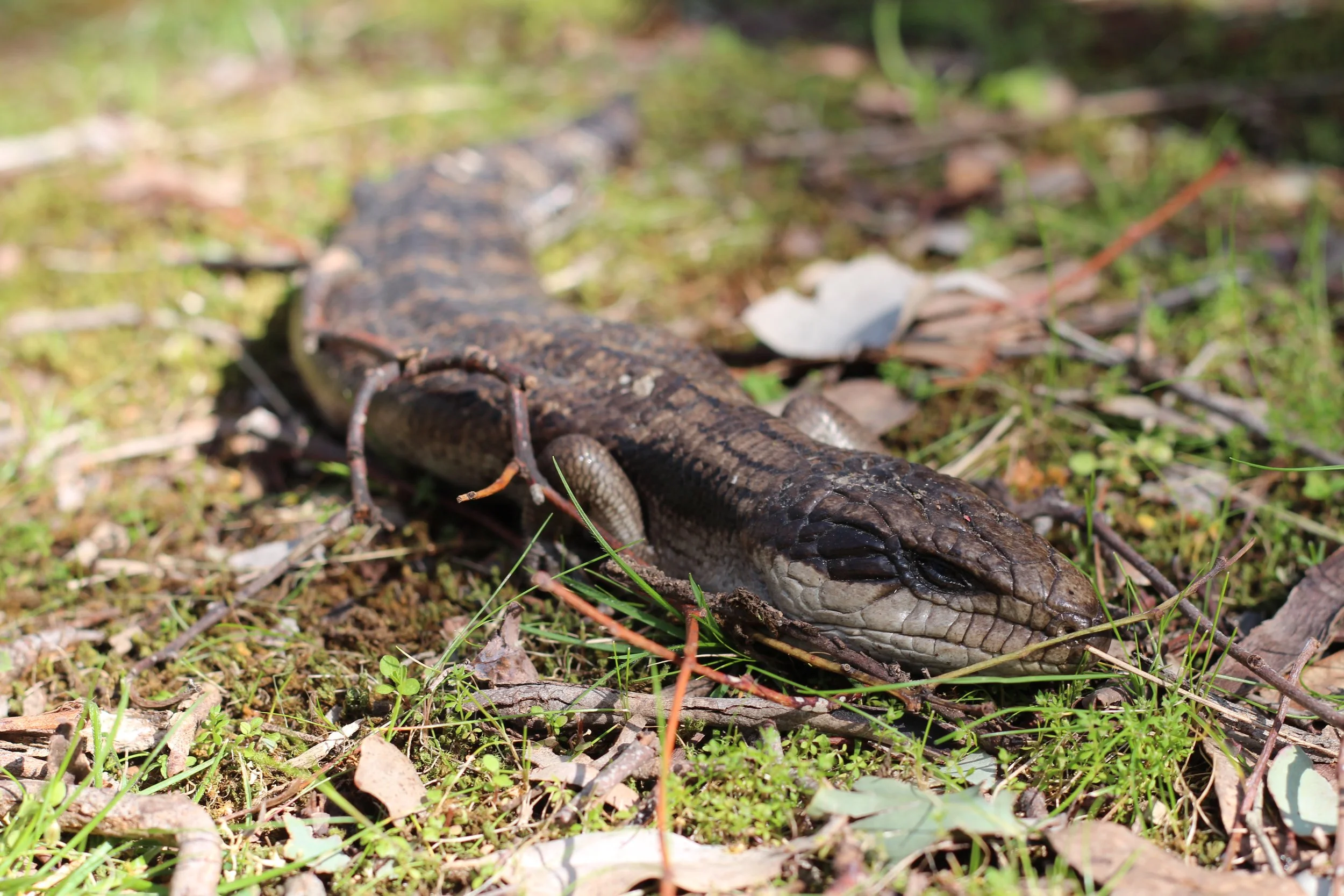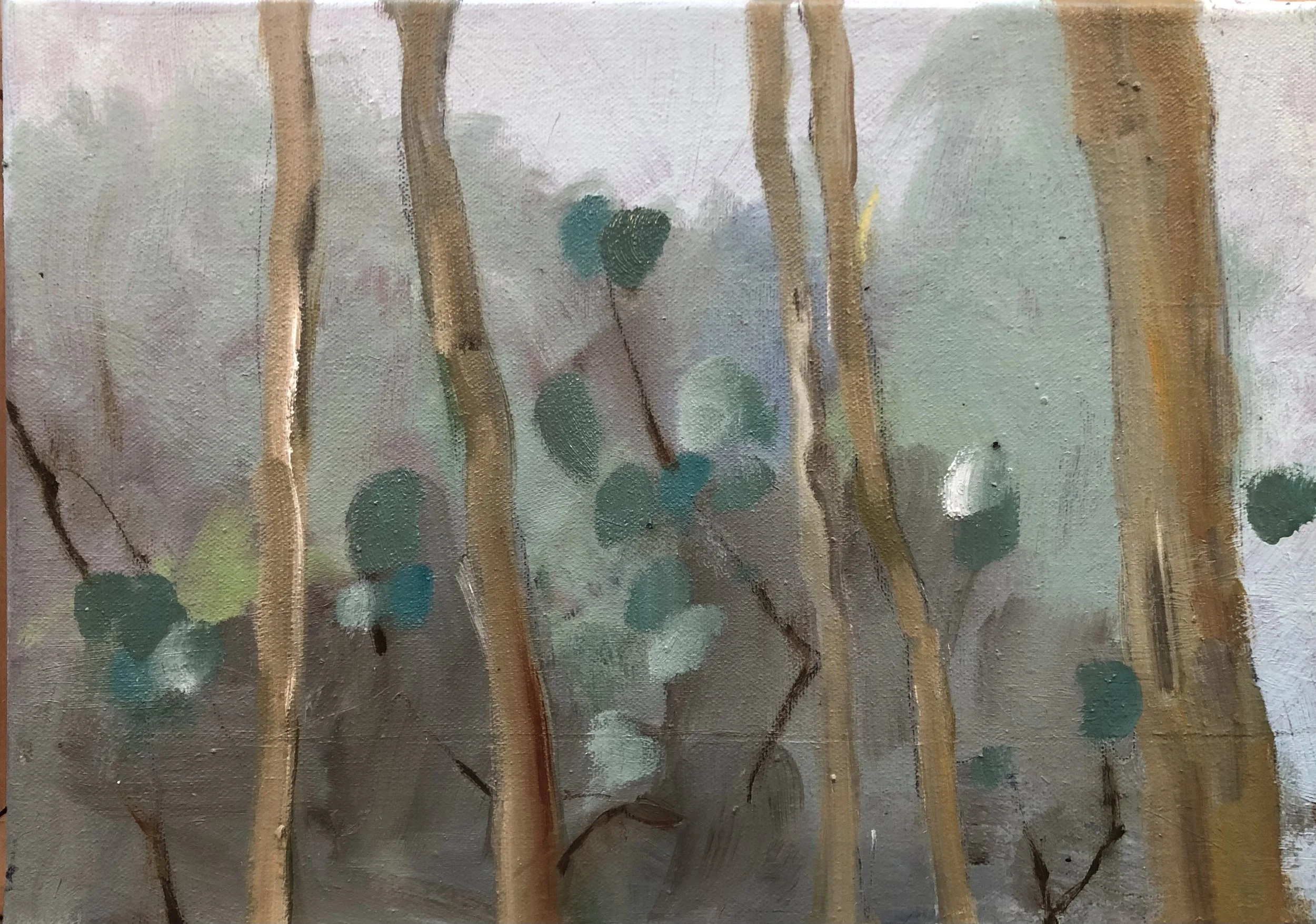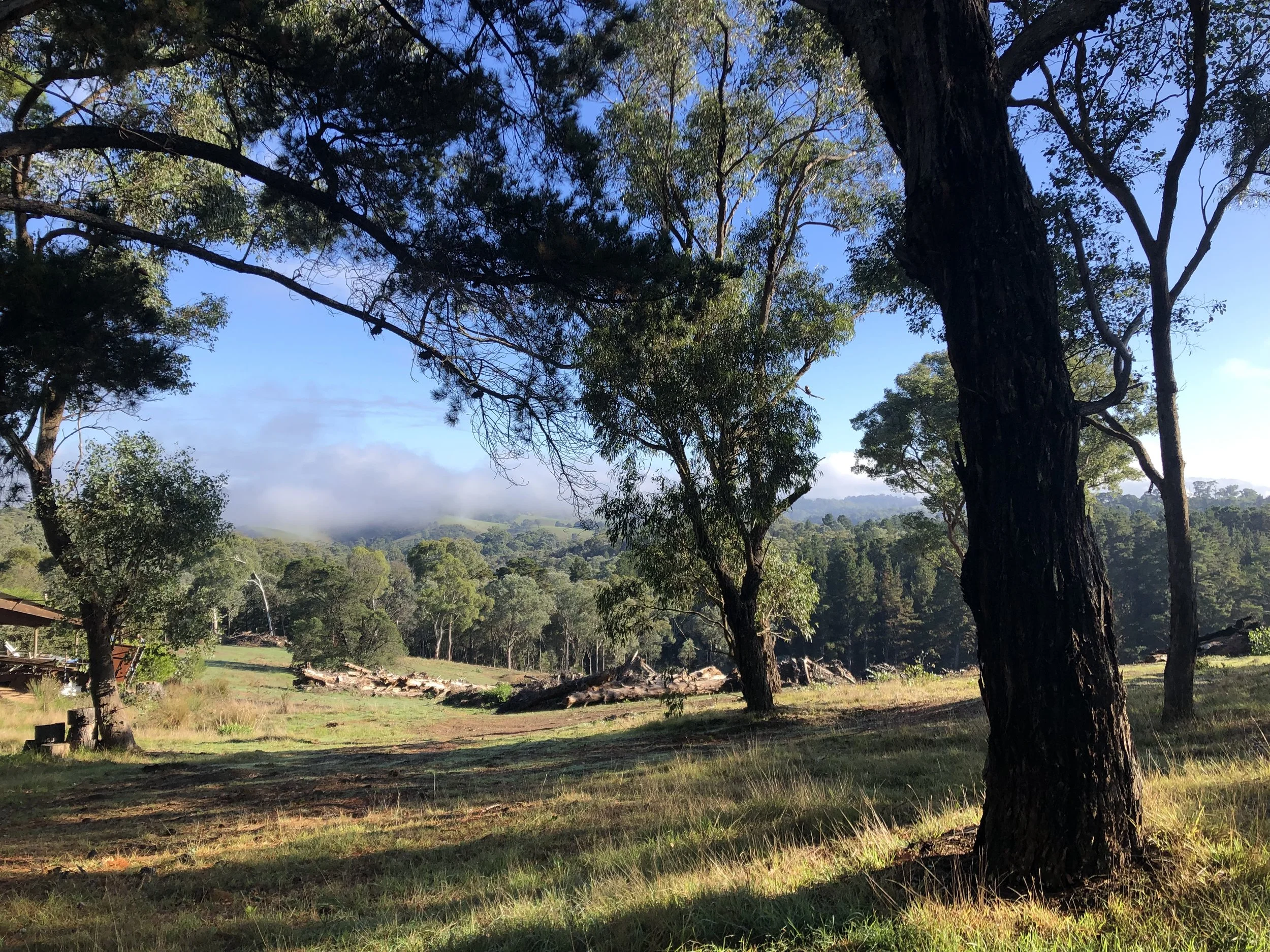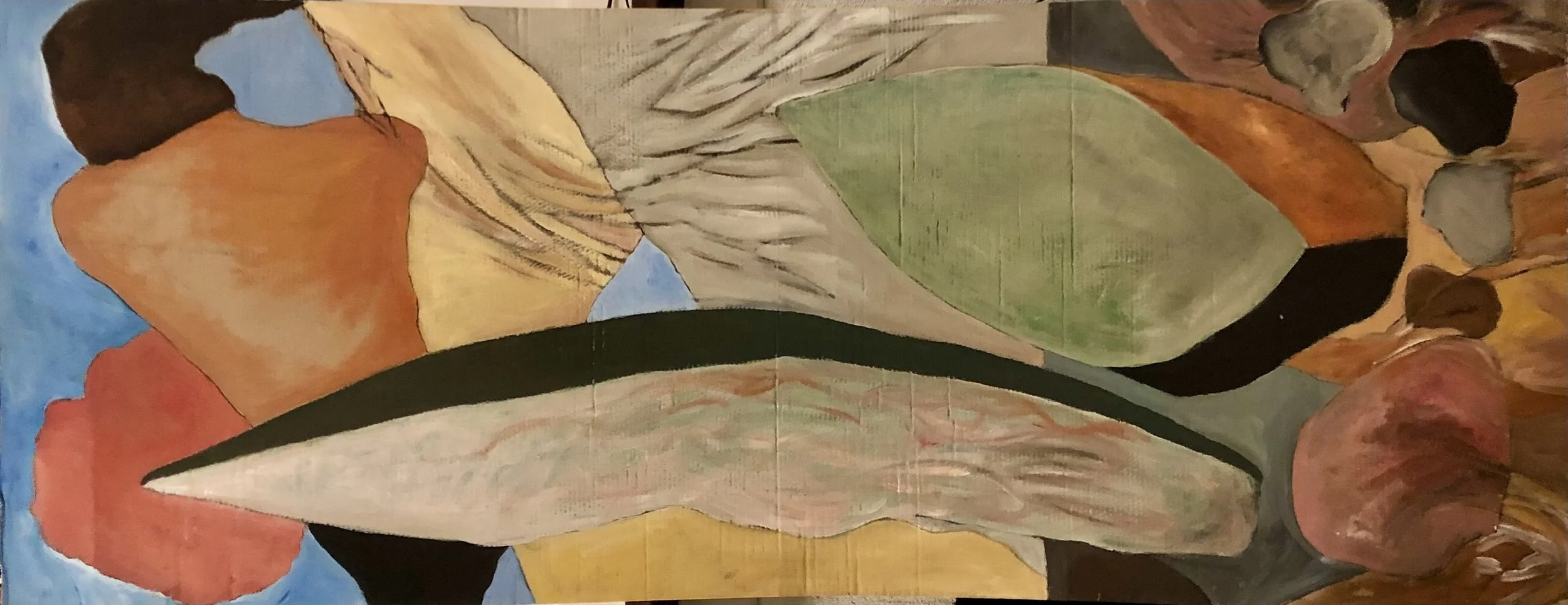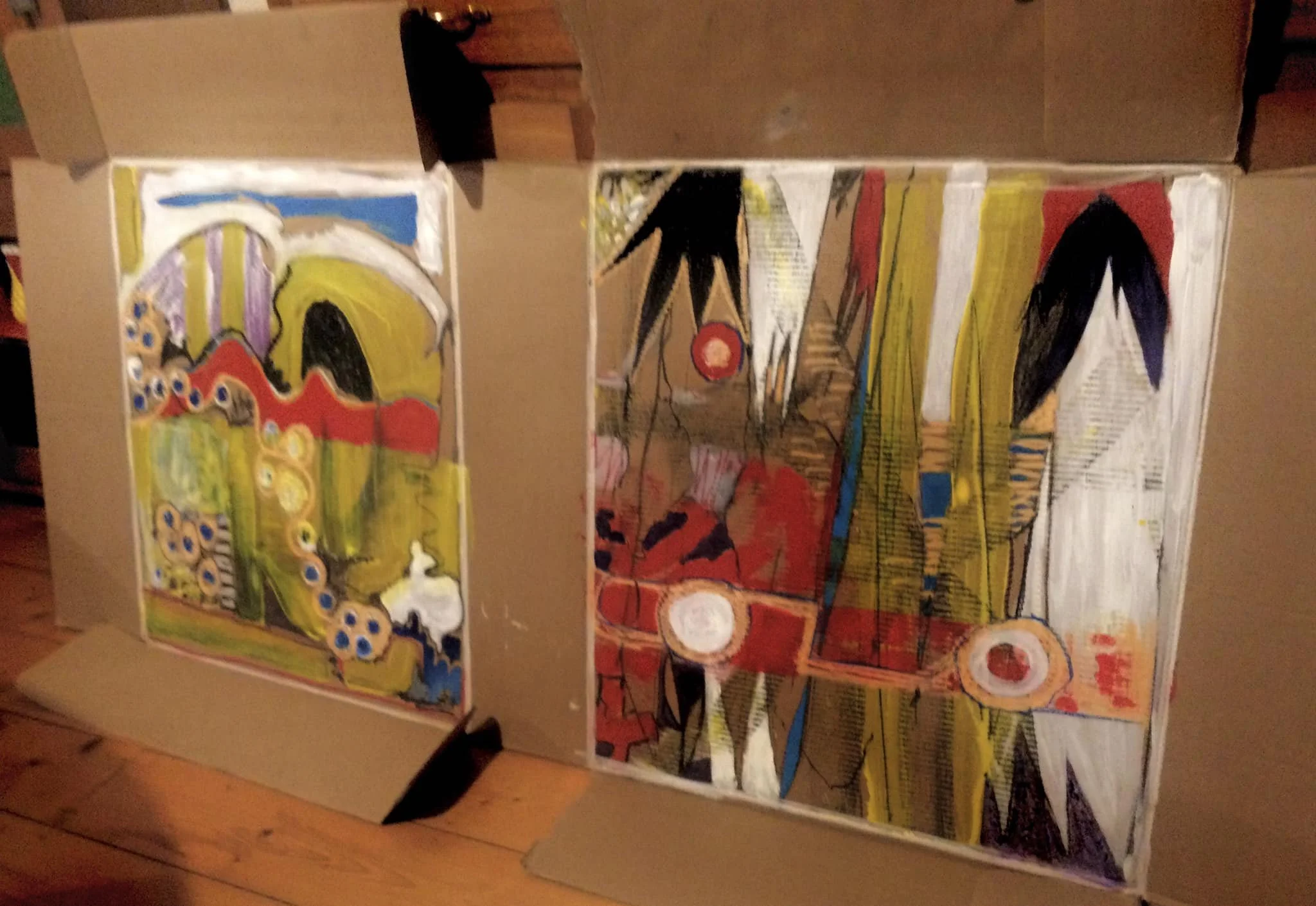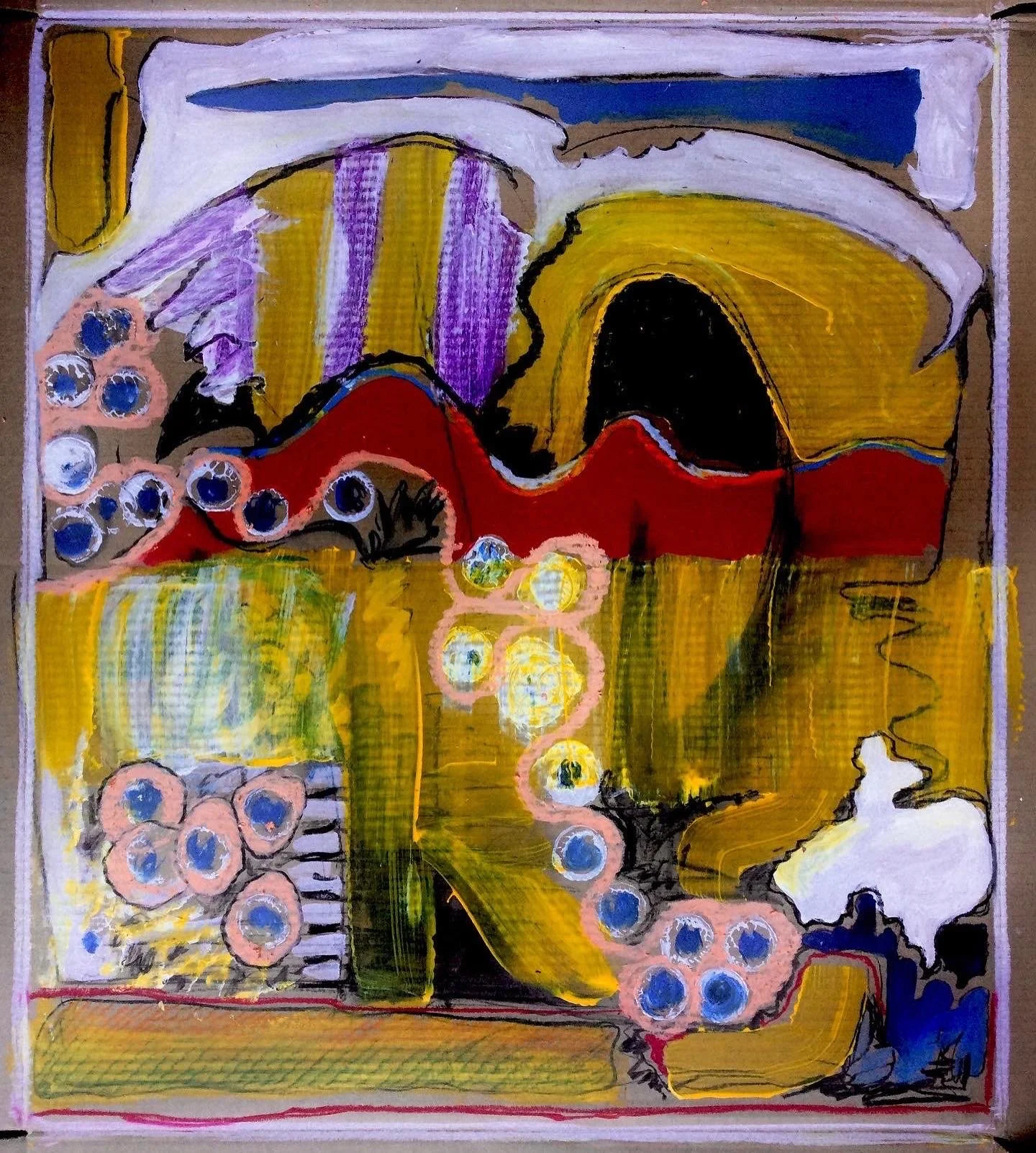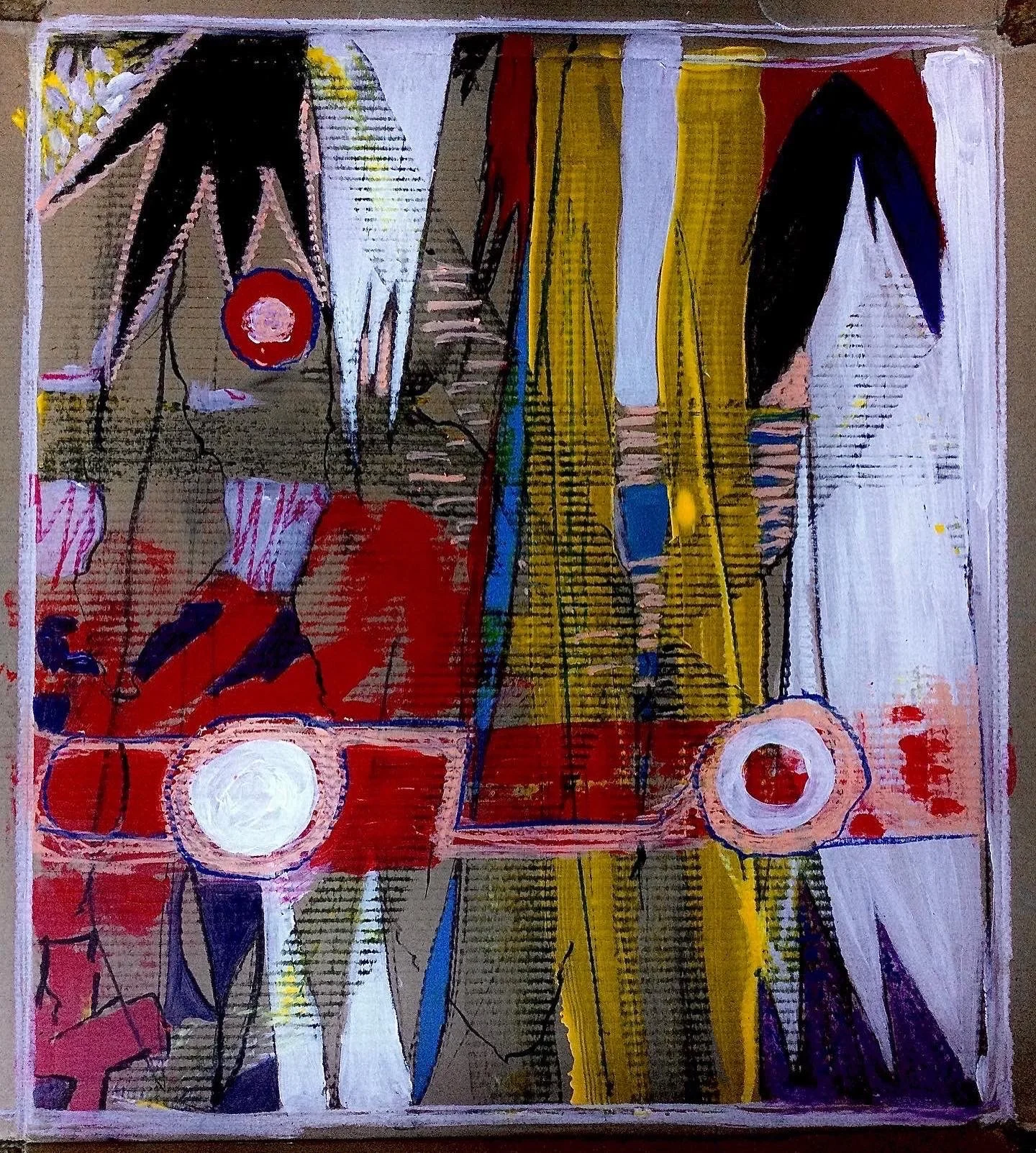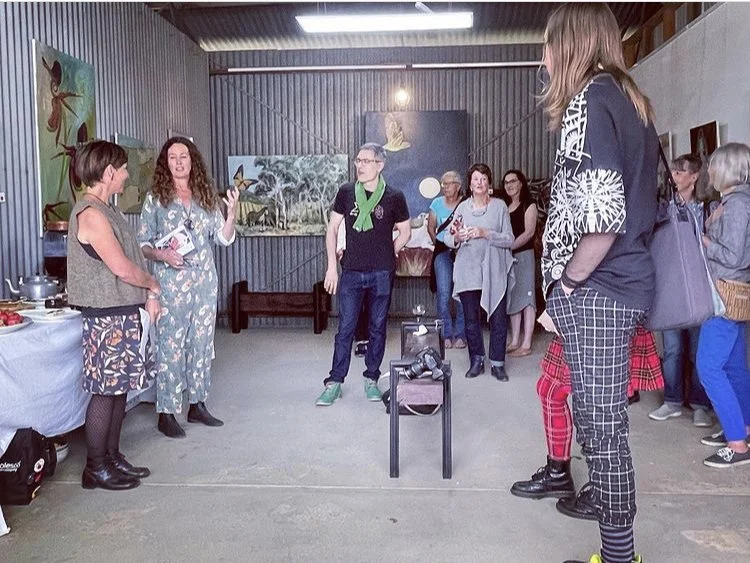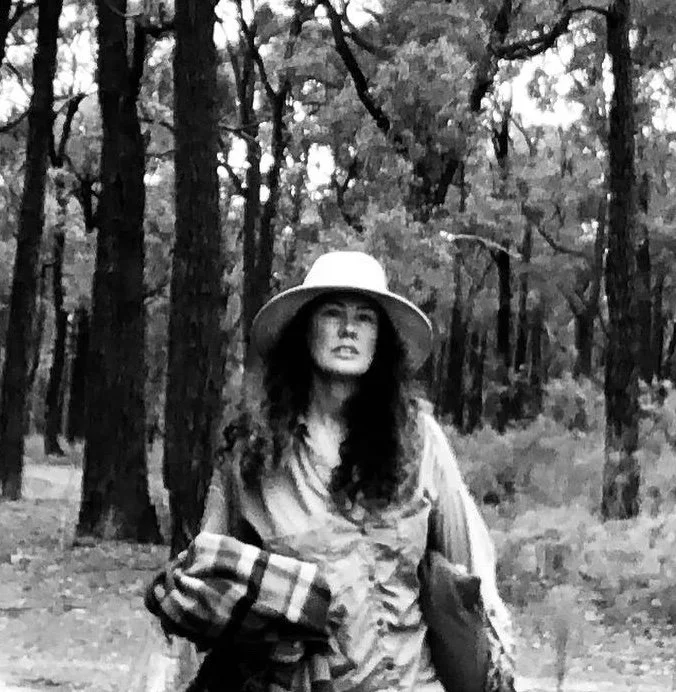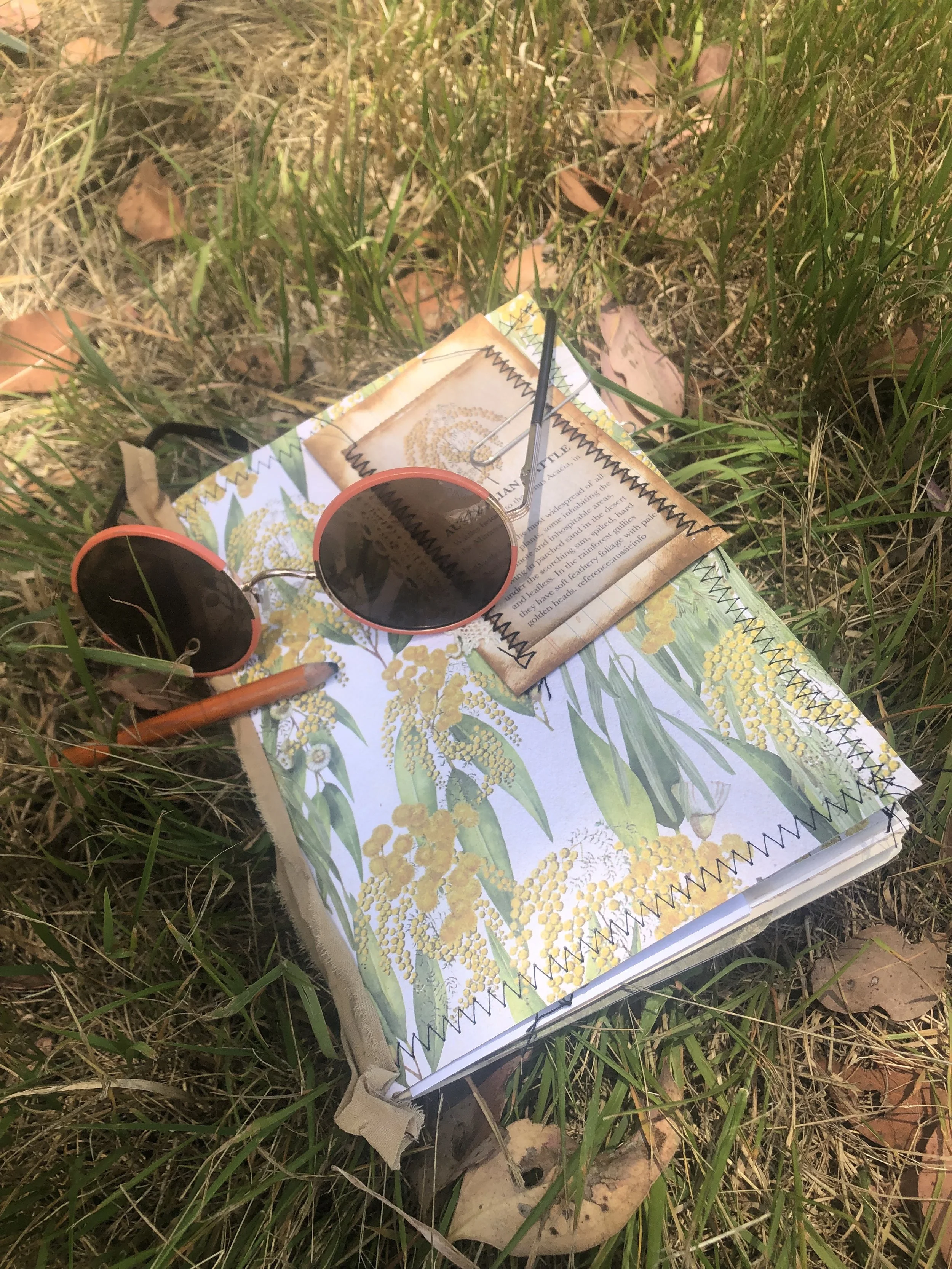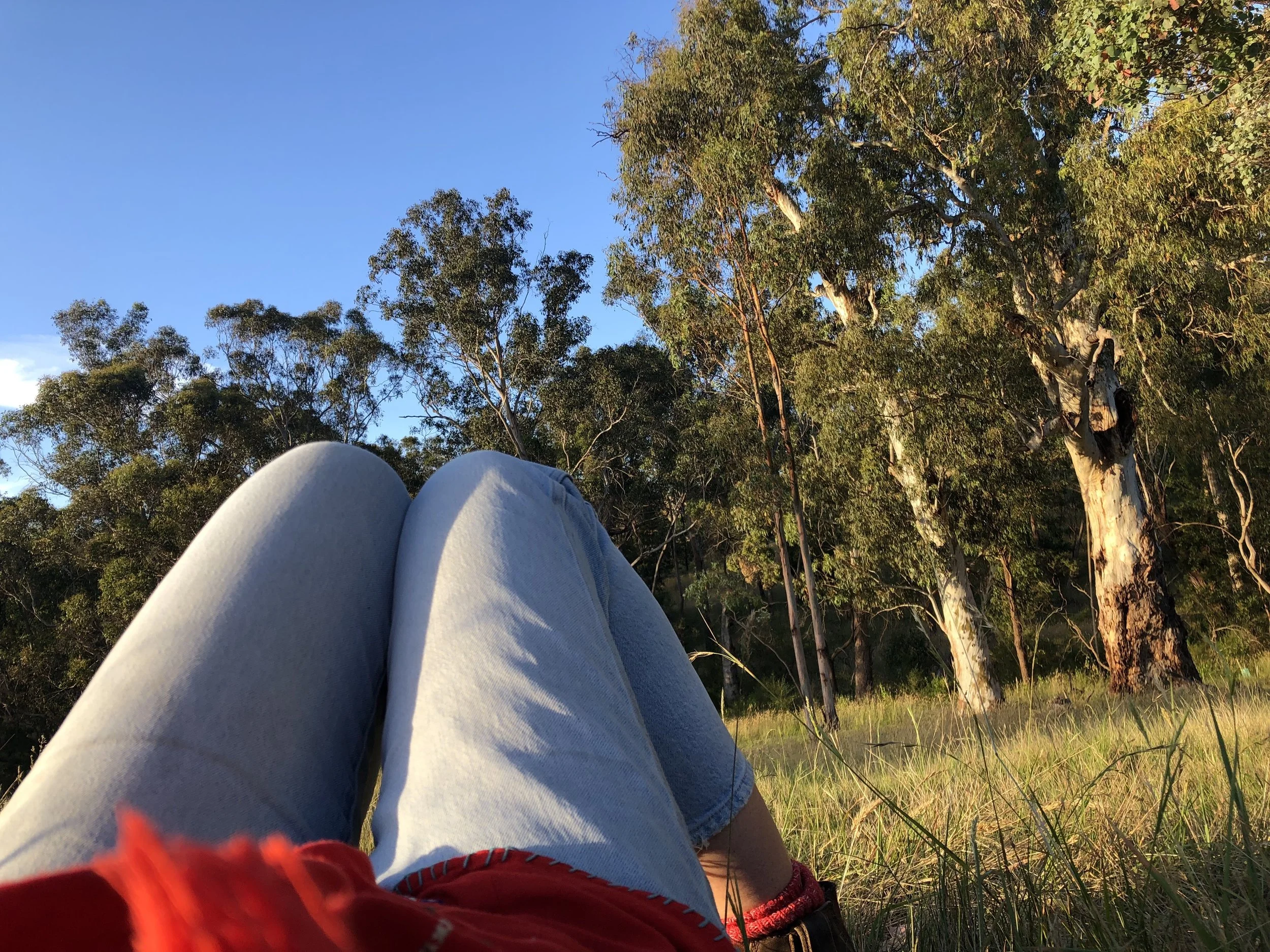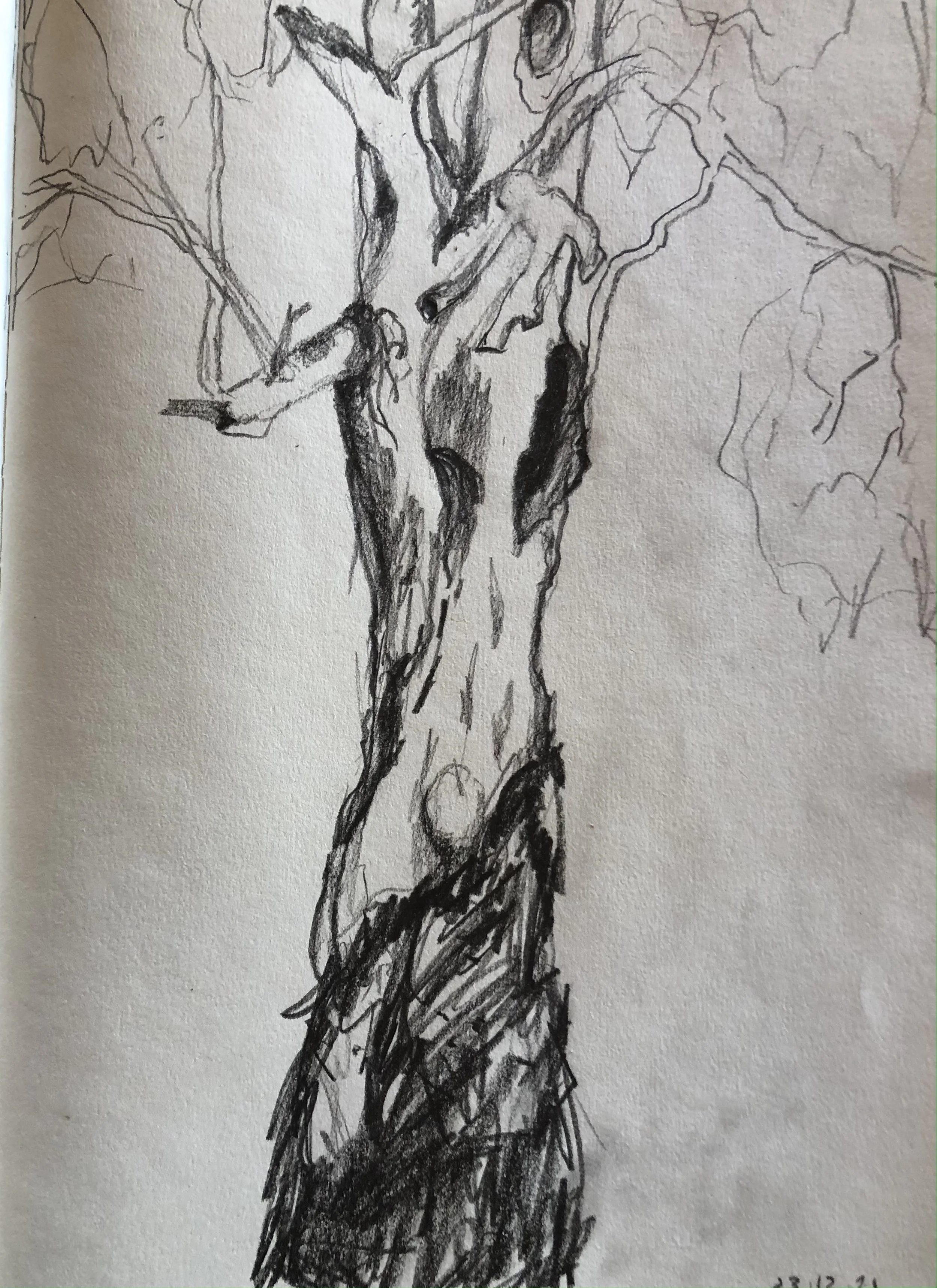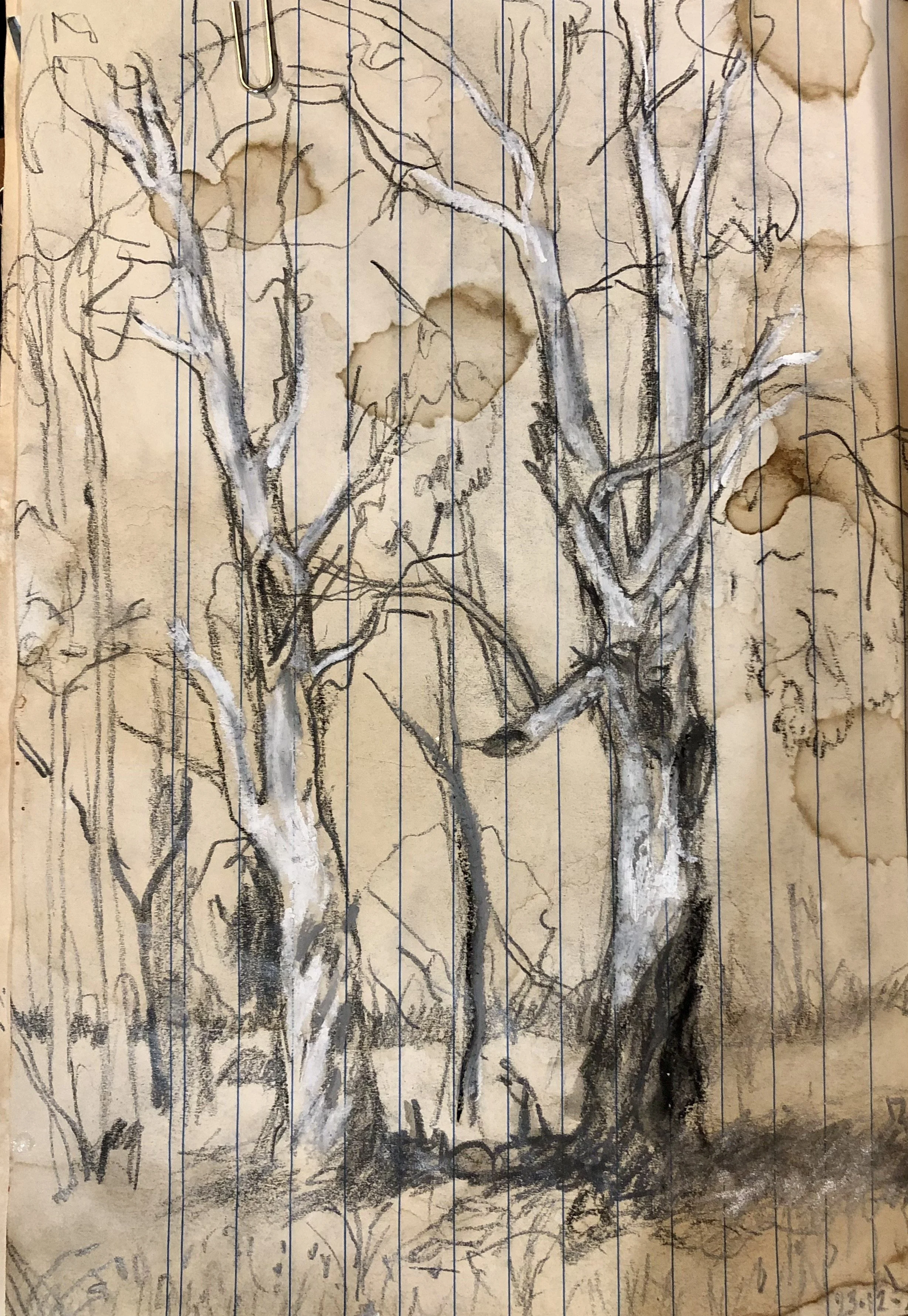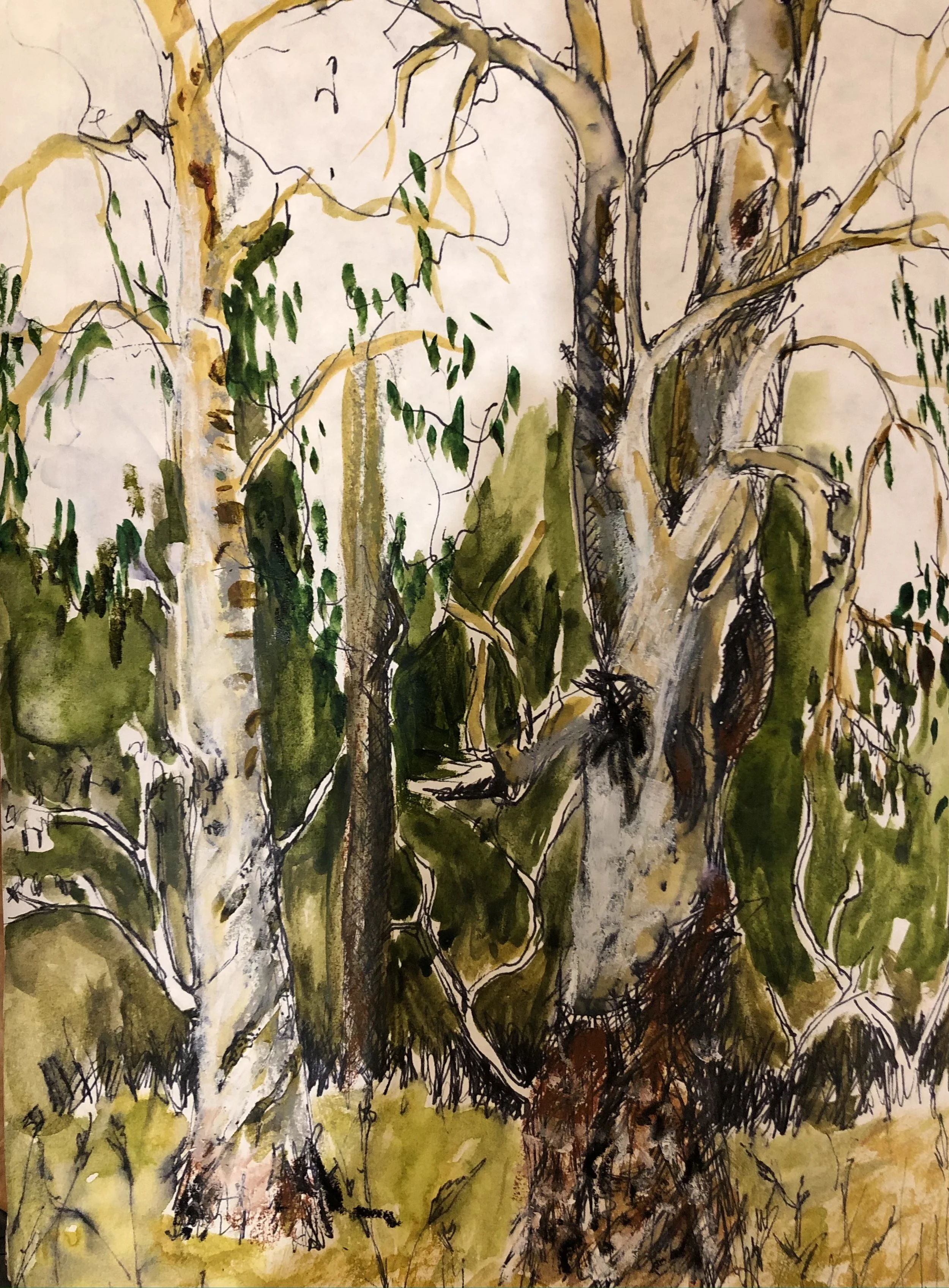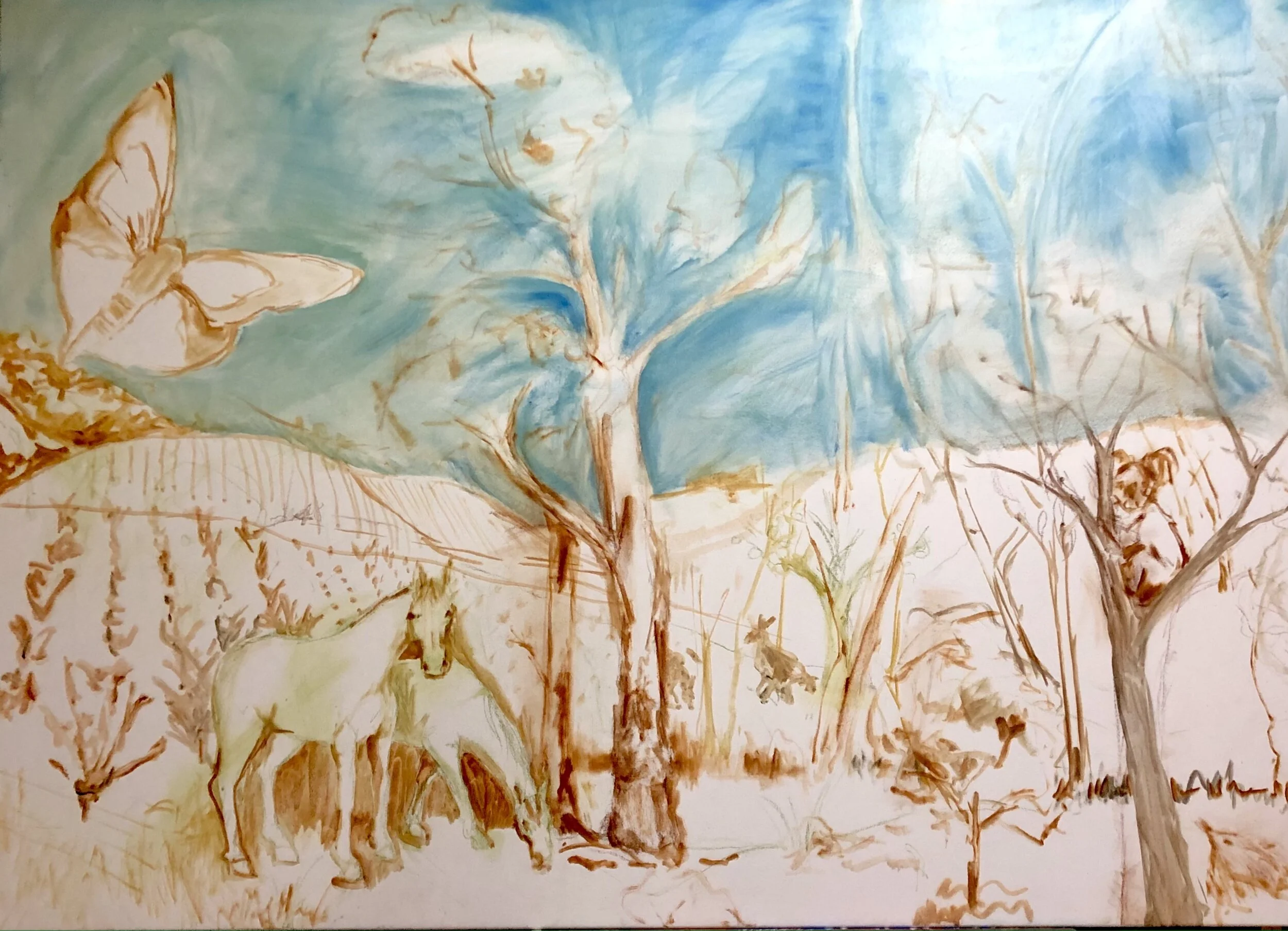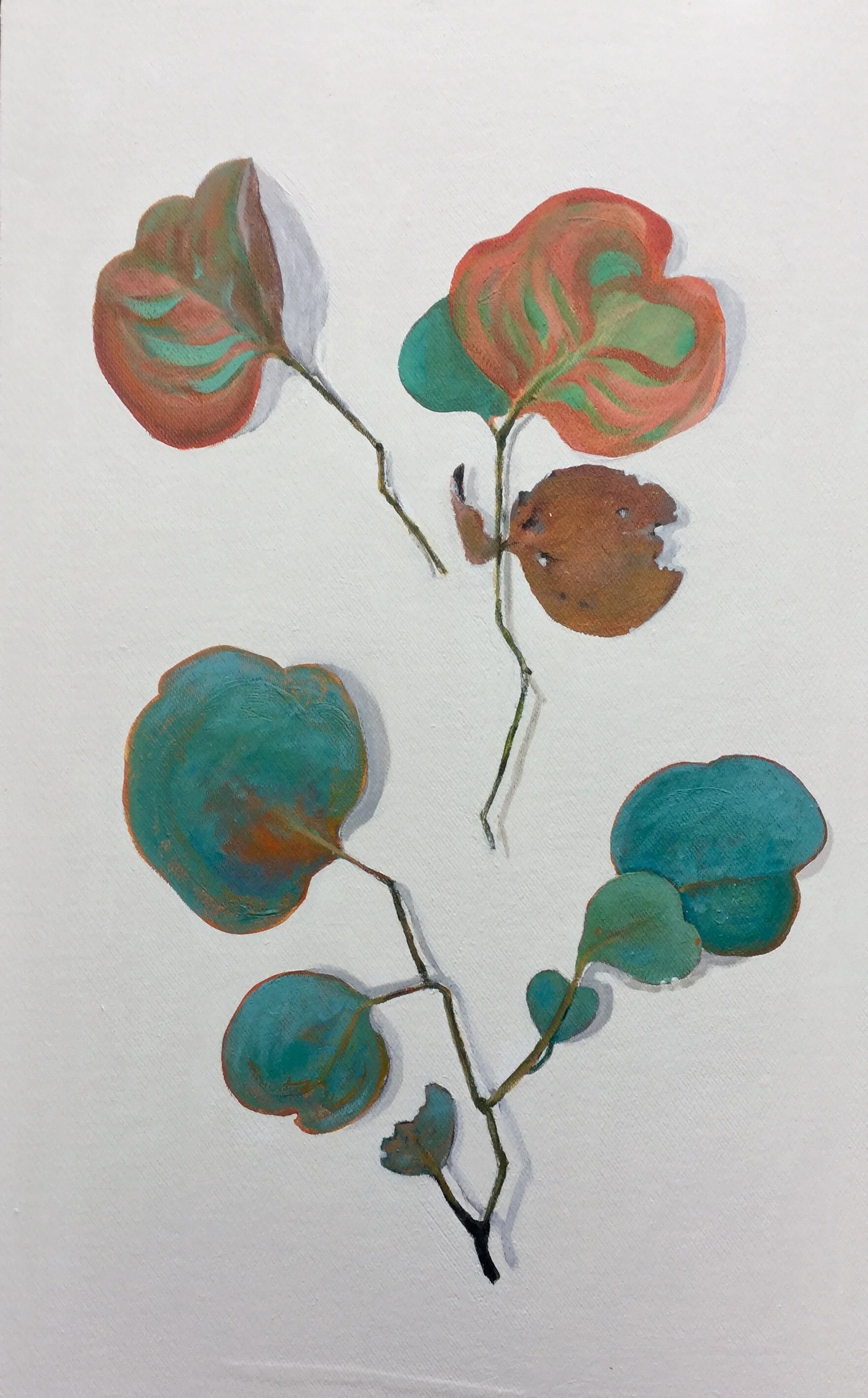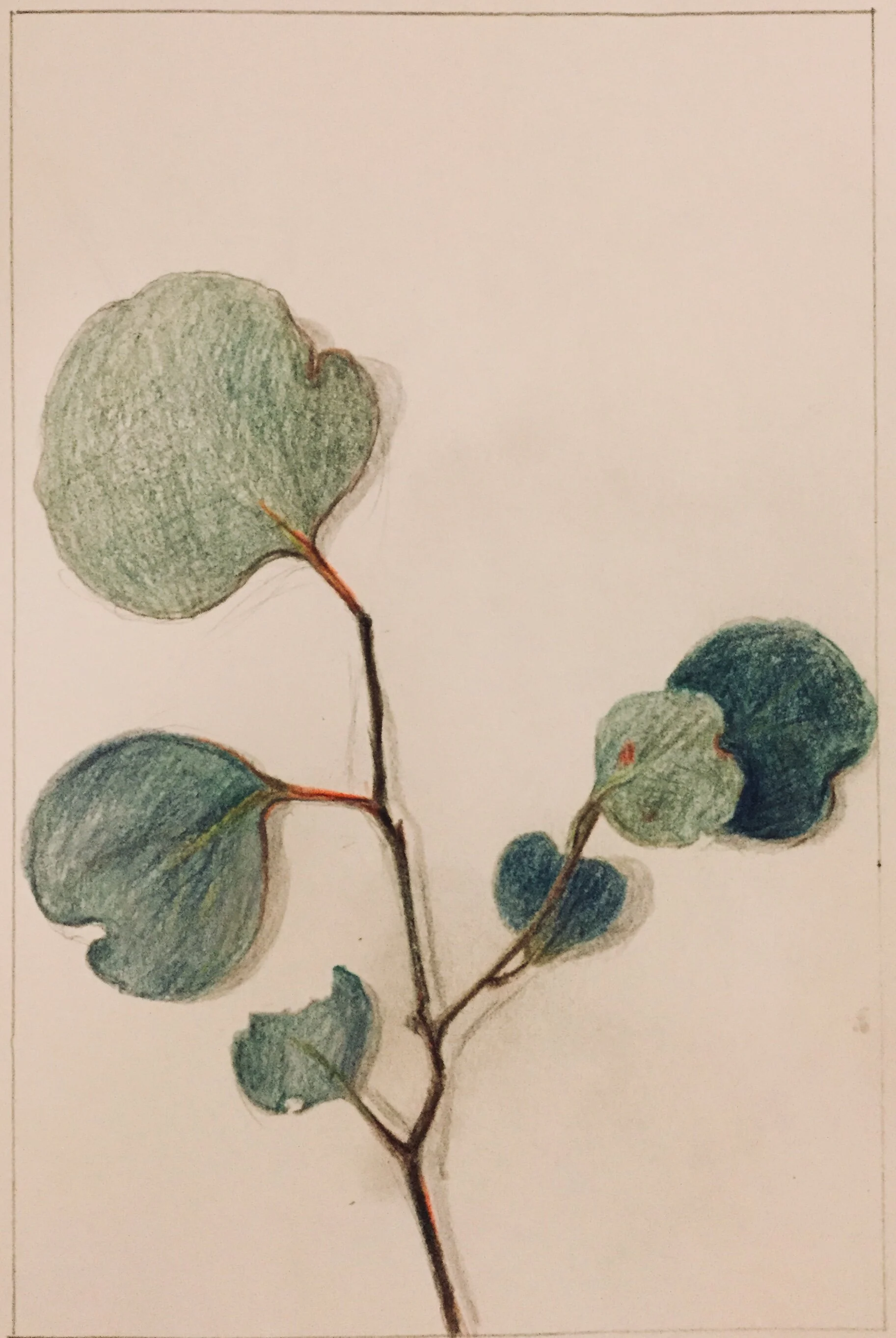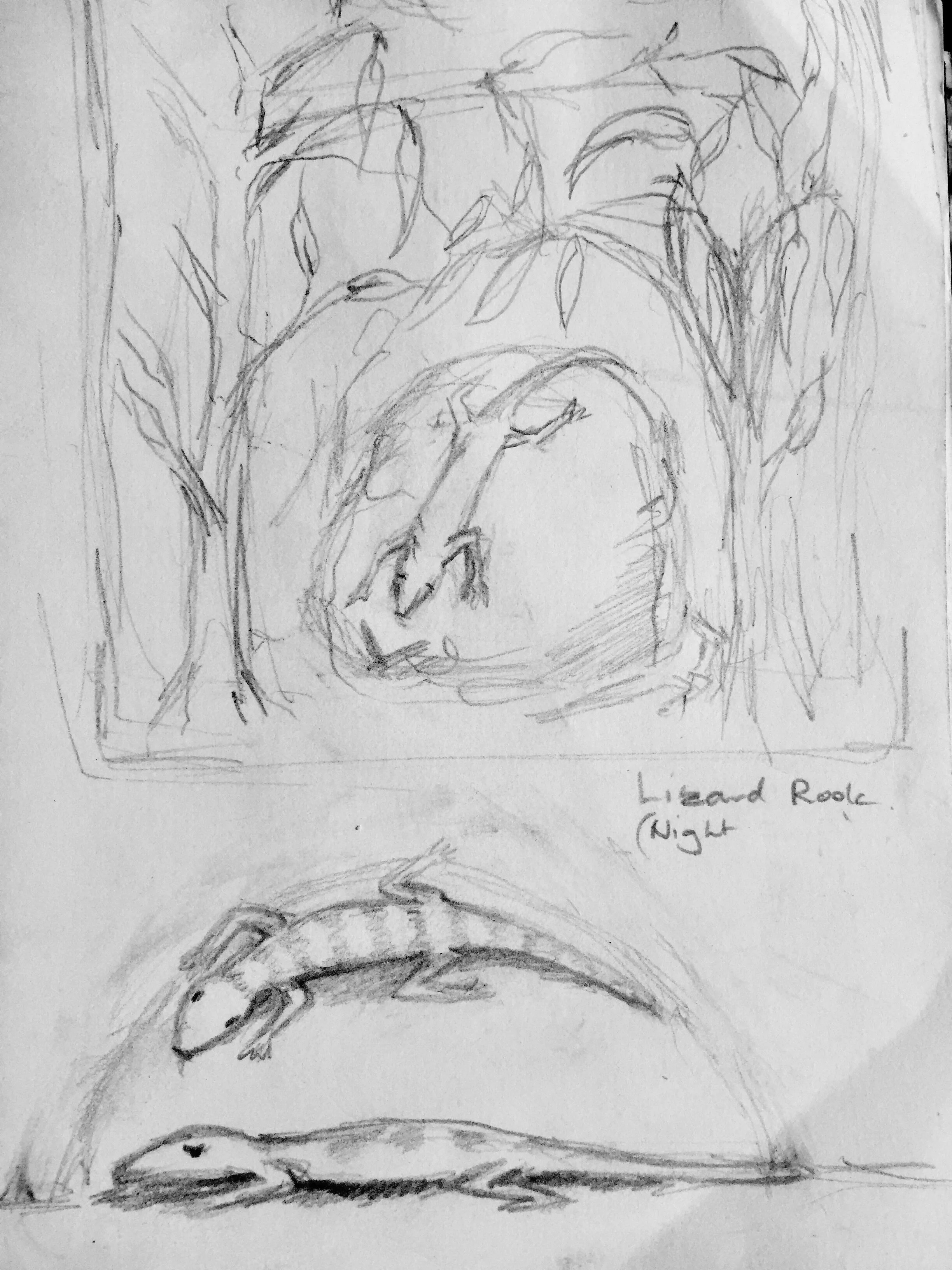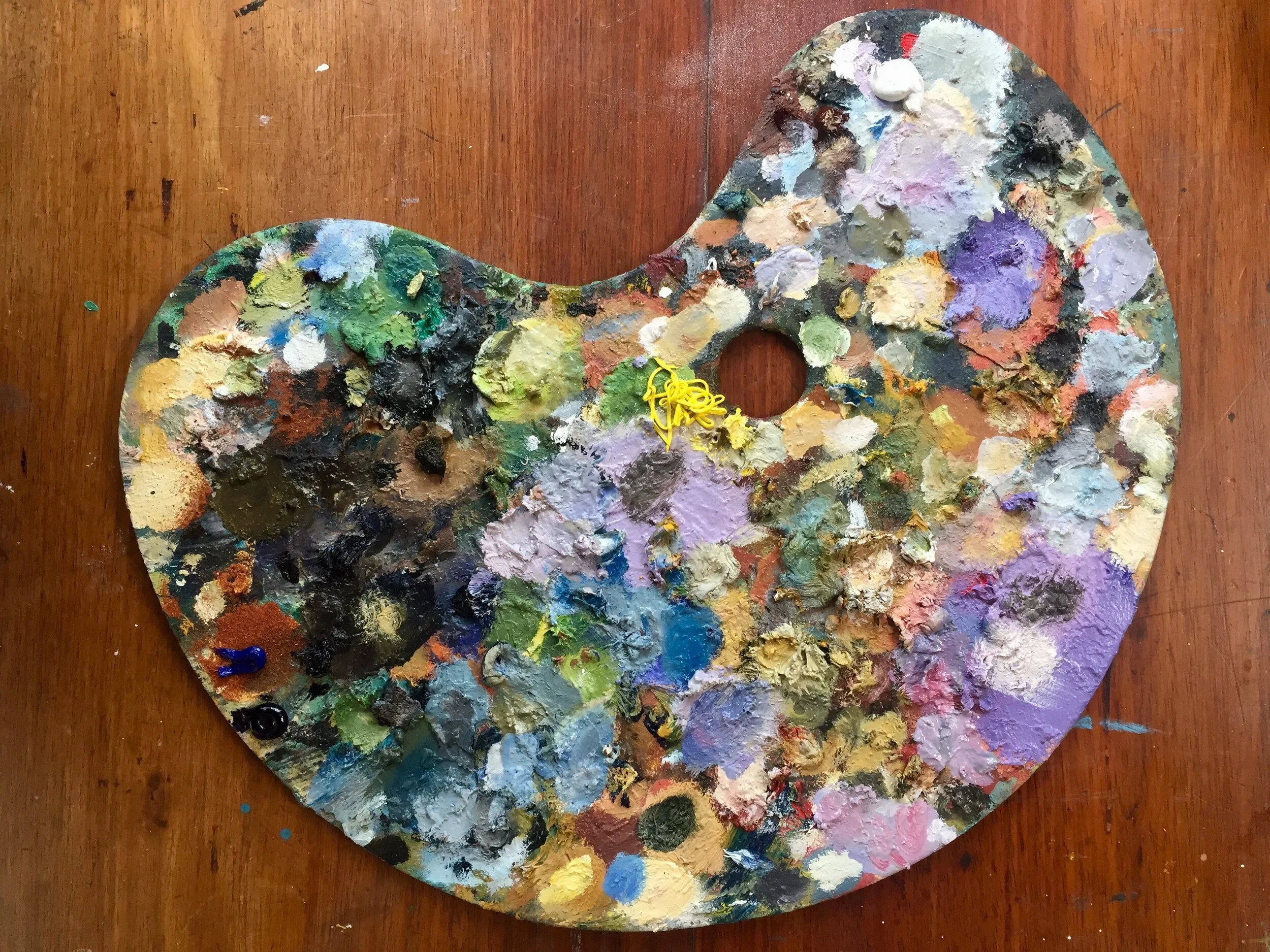Encounters with local wildlife and other animals. The notion of home and habitat, and the beautiful interrelationship with the tiniest beings indirectly facilitating life and habitable places for one another has come into focus. An encounter with a wombat entering my studio overnight and using their instinctual burrowing technique to turn the space on its head, has lead me to interpersonal responses through stencilling techniques. This can be seen alongside elevating subject matter such as hollow logs and other bush dwellings.
Transformation
Looking South Dunmoochin Autumn 2025
“I thought the earth remembered me, she took me back so tenderly, arranging her dark skirts, her pockets full of lichens and seeds. I slept as never before, a stone on the riverbed, nothing between me and the white fire of the stars but my thoughts, and they floated light as moths among the branches of the perfect trees. All night I heard the small kingdoms breathing around me, the insects, and the birds who do their work in the darkness. All night I rose and fell, as if in water, grappling with a luminous doom. By morning I had vanished at least a dozen times into something better.”
~Mary Oliver, Sleeping In The Forest
A Pattern Language
Lived experience tells me that Christopher Alexander’s book A Pattern Language is wonderfully significant. He and others have put together over 250 patterns that go into creating Urban, town and home spaces that have the nature to support us in not only physical, but sensed feeling. Written in the 1970’s it carries true awareness of how living structures can be built in a way that adds to our experience at home and in public spaces through design and construction. For me this way of planning and building is a valuable link to the paintings from Invisible Cities. Recently a new property with a shack, has come into my life and will provide me with the exciting creative challenge of building a new home! Simply put “..whatever you do, make sure it has inner beauty…You can change everything in this way….It comes from the heart 心から来る Kokorokar”
CASPA Exhibition
Open Studios
Farewelling these two recent paintings as they head off to their new home today. Thank you to everyone who came to Nillumbik Artists Open Studios at Dunmoochin, the engagement and conversations were invaluable. It was so great seeing the faces of very special people I hadn’t seen for so long! Making new friends near and far…and feeling the warmth of family, fellow artists and friends xo
Framing credit to my clever and kind father!
LookingWest
LookingNorth20
Fertile Country
Are there places on Earth where conception is particularly present? An experience in The Kimberley pointed to a particular rock, called Blue Tongue Rock, that could be visited and called into being. The cottage where I am staying here at Dunmoochin is surrounded by two Blue Tongue lizards, who lay in the sun almost every day. This one pictured, appears old and easy prey. So far the kookaburras come and look, and then fly away.
Dunmoochin First Impressions
Leaning heavily on the cultural richness of this place (with a beginners mindset), and it’s historical cast of dedicated artists. It gives so much, in the relationship to nature and to a fully intentional place, with others, to create. I am deeply appreciative of those who have been and are part of seeing this artist residency vision of Clifton Pugh’s through to now. @dunmoochin #dunmoochin
https://www.facebook.com/Dunmoochin?mibextid=LQQJ4d
Artist residency at Dunmoochin
On April the 26th 2024 I began a 12month residency at Dunmoochin in Cottles Bridge, the creation and home of renowned Australian painter Clifton Pugh. The Foundation is run by a number of board members including Clifton Pugh’s son Shane and grandson Lucas Pugh. It is made up of a number of residential dwellings and studios, and is set in the bush. I am in the character filled, historic Cottage, and have a studio to paint in. it feels nurturingly familiar with such a daily life connection to nature and the elements.
It was as though the stars aligned 4 weeks ago, and suddenly here I am living in Dunmoochin amongst other artists and writers, already inspired to get some extended painting time in the studio. More updates with pictures of this peaceful and nature embude place to come.
April view looking across to Cottles Bridge from Panton Hill
The weight of the world - Letting go
2.5m x 1m playing with shards of cardboard and acrylics
Out of the Box
One way to approach a new computer (when you have every cable invented, except the one you need! )…..
Wildwood Days Exhibition
In April this year I held a small exhibition of paintings, created mostly in or between lockdowns in regional Victoria. The show was well supported by family, friends and local community.
Iron Box Forest
Wildflower season is usually between August and October here in Victoria Australia. Often it is like finding the most beautiful treasure when the tiny flowers appear with resilience through rocky ground. Am becoming a forest dweller I think, seeking comfort in nature and ways to express my appreciation for it. Being surrounded by nature is a great experiential teacher for being present and really seeing. As you can tell, it is now January, so this Ironbark painting is taking a while to resolve!
Visiting Old Friends
A much needed comforting few days to sketch some old friends at my family home before Christmas. A chance to have a good look at the old candle bark trees and soak in how they twist and turn, branch off and hold their leaves. Sitting on the earth has never been so beneficial, as the world feels overrun with failings to take up decisive action on keeping our planet not only habitable but with a thriving ecology.
Junk Journal by Curious Chronicles
Hurstbridge summer 2021
9B lead pencil
Chinagraph and oil pastel sketch
Mixed media sketch
Learning to Paint again and again for the first time
Beginning this larger landscape painting has taken time to gather together elements to work with. Although the conception was a visual in my mind inspired by Wild Wood Days , the planning process has been intermittent and spread out over months. With this work I am exploring a new painting style , where I am trying to work with edges in a non linear way… pushing and pulling instead of drawing. Enjoying the challenge and have just sketched out the composition and begun exploring the shadows. Aware to not over work the painting in my attempt to learn how to achieve a painterly style.
Eucalyptus polyanthemos Red Box
Here is my take on this local native species. Size 94 x 58 cm Gloss acrylic on board. Nearly ready for an upcoming group exhibition at the Rushworth ART Depot in May.
The Red Box is of comfort and happiness, as it lines the road leading to where I was born and is also native to where I now live .
The Rushworth ART Depot has been fortunate to have local environmentalist and landscape architect Louise Costa run a series of Botanical drawing classes based on Dynamic Drawing and her own in-depth knowledge of plants. Lou introduced two new species each week explaining their qualities and how they may be included in a garden . Providing habitat for wildlife and insects, the idea of including more natives appeals.
Our only home
...a creative stretch and release. Feeling blocked and shutdown entering only a 5 day lockdown. Wanting to free up. Doesn't always feel good - like making a massive embarrassing mess...but it does get the energy flowing and that is always a good thing.
Our only home
The Arts in Australia and New Zealand
Listening to this conversation between Kirsten Lacey (Paisley) director of the Auckland Art Gallery and Melbourne Philanthropist Carrillo Gantner this afternoon. Reflecting on the status of support for the Arts in Australia, and particularly during the Covid pandemic. They both agree on the devistating effect this time is having and will continue to have on the Arts in Australia where the government has demonstrated very little support.
Kirsten initiated a new Art Museum for Shepparton whist in the role of director there, and was successful in engaging some funding from Federal and State governments as well as other philanthropic fund raising. Carrillo also played a pivotal role by donating his significant Aboriginal Art collection and wrote an important letter to the local mayor explaining the vital role of the Arts in communities.
Thanks to Kirsten’s kind support I was fortunate to meet Carrillo whilst assisting to collect part of his donated Aboriginal Art Collection from his Melbourne home in 2014, and transport it to the Shepparton Art Museum, where we then documented and archived the inspiring pieces. This Art work will be exhibited within the new SAM !
Cultured Conversations Link: https://www.aucklandartgallery.com/page/cultured-conversations-with-carrillo-gantner
The site of the new Shepparton Art Museum is located on the lake and is due to be completed by early 2021.
Blue Tongue Rock
One weekend whilst at Mulan in remote Western Australia, we had the opportunity to go and visit the Blue Tongue Lizard Rock with Veronica Lulu and Eileen. The Blue Tongue Rock is nestled in the bush a short drive out from the community, heading away from Lake Paruku. Lulu (Veronica) assured Kevin, Andrea and Julie that they would receive many grandchildren by each placing their hand on the rock. Lulu asked if I got husband, she said ‘Works when you got partner ’ . Well, yes I had a partner, I think, but he was 3500km away. With warmth. lightness and intent, she placed her hand on my belly, a hand on the Blue Tongue rock, and spoke in Kukatja. That night something moved in my ovaries that I hadn’t experienced before ! :)
Colour inspiration for Blue Tongue Lizard Rock - Rushworth Growlers Hill Wildflower Sanctuary
Sketches for Blue Tongue Rock
Painting Space
The pallete is like a landscape to be travelled and mined for pigment in this case. Occasionally I loose track of a colour and stumble across another resulting in happy accidents and at other times lost days fumbling around to recover a painting from a divergence in colour pallete consistency. Right now this is the situation with ‘Fish Out of Water’. Today I am back in the studio attempting to recover this painting, putting aside the free abandon with which I began this work. Discipline is needed to push on with eyes open and brittle edges soothed.
Moving a bit too slowly. Fingers crossed I can bring the Galaxias into being today.
This way of working with a ‘disorganised’ palette for me, supports intuitive processes, discovery, creation, exploration and infinite possibilities within the boundaries of the kidney shaped board.
Updated Fish Out of Water.


